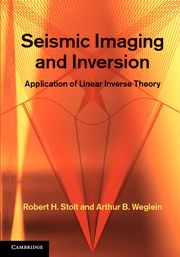Book Covers Application of Linear Inverse Theory

Order Book from Cambridge University Press The book, Seismic Imaging and Inversion, authored by the University of Houston’s Arthur B. Weglein and Robert H. Stolt of ConocoPhillips, will be available in February from Cambridge University Press.
Weglein is the Hugh Roy and Lillie Cranz Cullen Distinguished Professor in Physics, a professor of reflection seismology in the Department of Earth and Atmospheric Sciences, and the director of the Mission-Oriented Seismic Research Program. Seismic Imaging and Inversion is the first volume of a two-volume senior-level graduate text in exploration seismology and seismic physics covering the application of linear inverse theory.
Described as a valuable resource for working geoscientists, scientific programmers and theoretical physicists, the book serves as a fundamental guide to seismic imaging principles and algorithms and their foundation in inverse scattering theory.
Features of the book:
- Ties together different approaches to the seismic inverse problem by describing the various models of seismic propagation, reflection and imaging
- Enables a basic understanding of the imaging without being buried in mathematics, or a deeper understanding of the imaging with the help of linearized inverse theory
- Incorporates full three-dimensional algorithms
Cambridge University Press summarizes the book as follows:
Extracting information from seismic data requires knowledge of seismic wave propagation and reflection. The commonly used method involves solving linearly for a reflectivity at every point within the Earth, but this book follows an alternative approach which invokes inverse scattering theory. By developing the theory of seismic imaging from basic principles, the authors relate the different models of seismic propagation, reflection and imaging – thus providing links to reflectivity-based imaging on the one hand and to nonlinear seismic inversion on the other. The comprehensive and physically complete linear imaging foundation developed presents new results at the leading edge of seismic processing for target location and identification.
- Kathy Major, College of Natural Sciences and Mathematics